英语八大时态总结表
- 格式:docx
- 大小:13.62 KB
- 文档页数:5
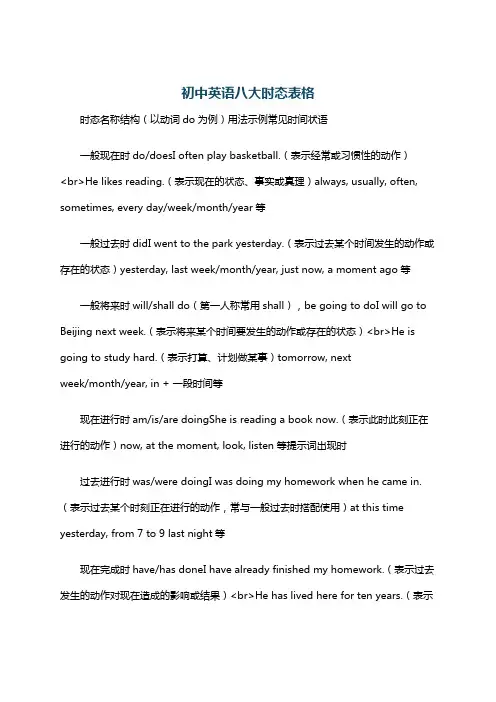
初中英语八大时态表格时态名称结构(以动词do为例)用法示例常见时间状语一般现在时do/doesI often play basketball.(表示经常或习惯性的动作)<br>He likes reading.(表示现在的状态、事实或真理)always, usually, often, sometimes, every day/week/month/year等一般过去时didI went to the park yesterday.(表示过去某个时间发生的动作或存在的状态)yesterday, last week/month/year, just now, a moment ago等一般将来时will/shall do(第一人称常用shall),be going to doI will go to Beijing next week.(表示将来某个时间要发生的动作或存在的状态)<br>He is going to study hard.(表示打算、计划做某事)tomorrow, nextweek/month/year, in + 一段时间等现在进行时am/is/are doingShe is reading a book now.(表示此时此刻正在进行的动作)now, at the moment, look, listen等提示词出现时过去进行时was/were doingI was doing my homework when he came in.(表示过去某个时刻正在进行的动作,常与一般过去时搭配使用)at this time yesterday, from 7 to 9 last night等现在完成时have/has doneI have already finished my homework.(表示过去发生的动作对现在造成的影响或结果)<br>He has lived here for ten years.(表示过去已经开始,持续到现在的动作或状态)already, yet, just, ever, never, for + 时间段, since + 时间点等过去完成时had doneWhen I got to the station, the train had already left.(表示在过去某个时间或动作之前已经发生或完成的动作,即“过去的过去”)by the end of last year, before + 一般过去时的句子等将来进行时will be doingI will be having a meeting at this time tomorrow.(表示将来某个时刻或时间段正在进行的动作)at this time tomorrow等。
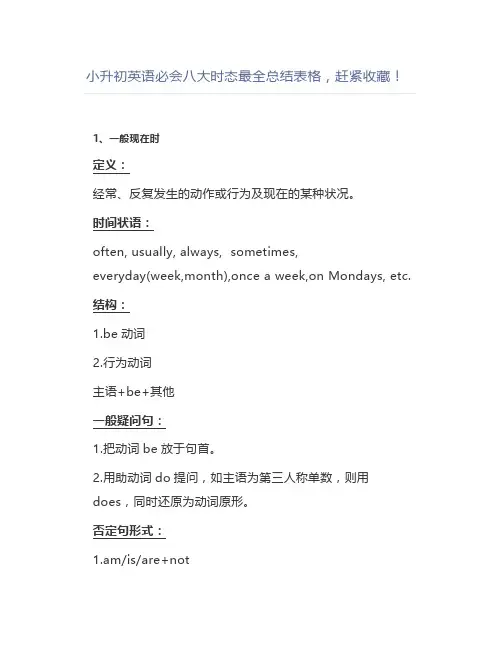
小升初英语必会八大时态最全总结表格,赶紧收藏!1、一般现在时定义:经常、反复发生的动作或行为及现在的某种状况。
时间状语:often, usually, always, sometimes,everyday(week,month),once a week,on Mondays, etc. 结构:1.be动词2.行为动词主语+be+其他一般疑问句:1.把动词be放于句首。
2.用助动词do提问,如主语为第三人称单数,则用does,同时还原为动词原形。
否定句形式:1.am/is/are+not2.此时态的谓语动词若为行为动词,则在其前加don’t;若主语为第三人称单数,则用doesn’t,同时还原行为动词。
2、现在进行时定义:表示现阶段或说话时正在进行的动作或状态。
时间状语:now, at this time, these days, etc.结构:主语+am/ is/ are +doing一般疑问句:把be动词放在句首。
否定句形式:主语+am/ is/ are +not +doing3、一般过去时定义:过去某个时间里发生的动作或状态;过去习惯性、经常性的动作、行为。
时间状语:ago, yesterday, last week(month, year…), in 2000, just now, one day, long long ago, etc.结构:1.was/were2.行为动词过去式一般疑问句:1.把was或 were放于句首。
2.用助动词did提问,同时还原为动词原形。
否定句形式:1.主语+was/were+ not2.在行为动词前加do在其前加didn’t,同时还原行为动词。
4、过去进行时定义:表示过去某段时间或某一时刻正在发生或进行的动作或行为。
时间状语:at this time yesterday或以when引导的谓语动词是一般过去时的时间状语等。
结构:主语+was/were+ doing一般疑问句:把was或were放在句首。
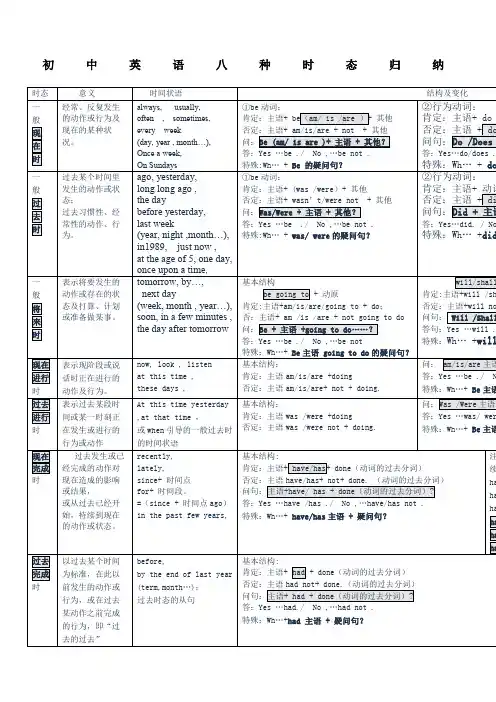
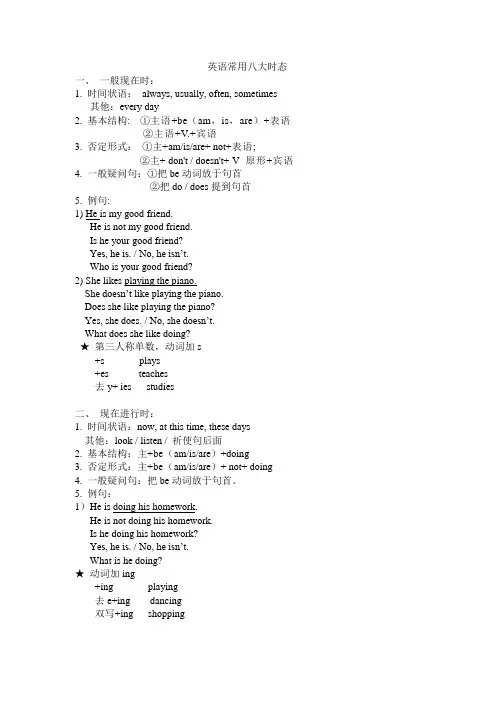
英语常用八大时态一、一般现在时:1. 时间状语:always, usually, often, sometimes其他:every day2. 基本结构: ①主语+be(am,is,are)+表语②主语+V.+宾语3. 否定形式:①主+am/is/are+ not+表语;②主+ don't / doesn't+ V 原形+宾语4. 一般疑问句:①把be动词放于句首②把do / does提到句首5. 例句:1) He is my good friend.He is not my good friend.Is he your good friend?Yes, he is. / No, he isn’t.Who is your good friend?2) She likes playing the piano.She doesn’t like playing the piano.Does she like playing the piano?Yes, she does. / No, s he doesn’t.What does she like doing?★第三人称单数,动词加s+s plays+es teaches去y+ ies studies二、现在进行时:1. 时间状语:now, at this time, these days其他:look / listen / 祈使句后面2. 基本结构:主+be(am/is/are)+doing3. 否定形式:主+be(am/is/are)+ not+ doing4. 一般疑问句:把be动词放于句首。
5. 例句:1)He is doing his homework.He is not doing his homework.Is he doing his homework?Yes, he is. / No, he isn’t.What is he doing?★动词加ing+ing playing去e+ing dancing双写+ing shopping三、一般过去时:1. 时间状语:ago, yesterday, last week, just now,this morning, the day before yesterday,in 1990, in the past2. 基本结构:①主+ be(was were)+表语②主语+V过去式+宾语3. 否定形式:①主+be(was/were)not+表语;②主+did not +V(原形)+表语4. 一般疑问句:① was were放于句首;② did用于句首,动词变回原形。
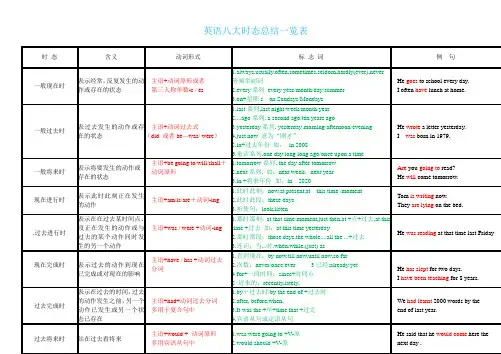

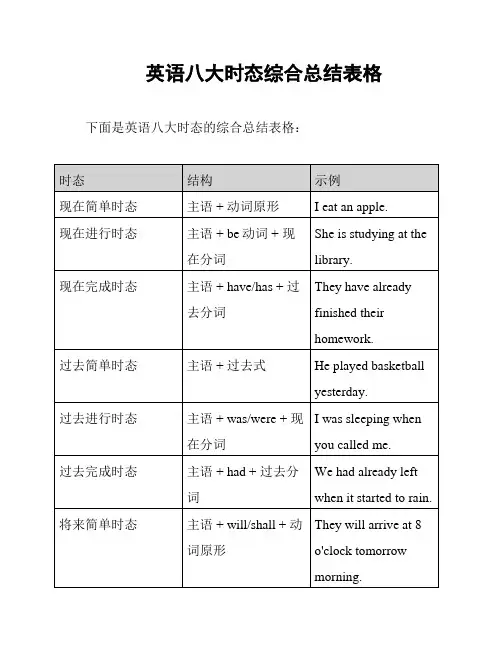
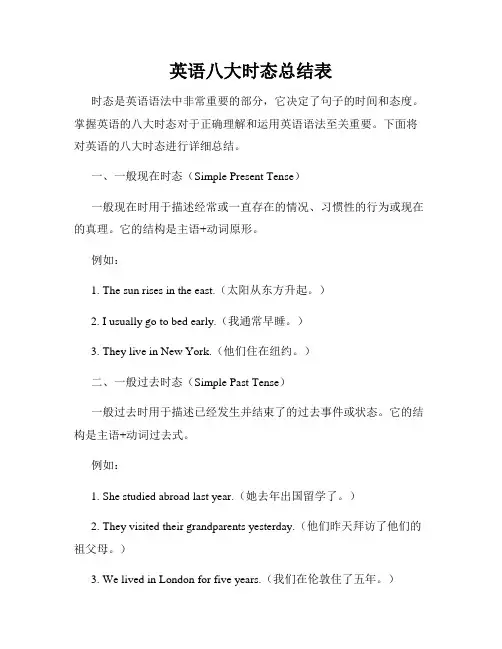
英语八大时态总结表时态是英语语法中非常重要的部分,它决定了句子的时间和态度。
掌握英语的八大时态对于正确理解和运用英语语法至关重要。
下面将对英语的八大时态进行详细总结。
一、一般现在时态(Simple Present Tense)一般现在时用于描述经常或一直存在的情况、习惯性的行为或现在的真理。
它的结构是主语+动词原形。
例如:1. The sun rises in the east.(太阳从东方升起。
)2. I usually go to bed early.(我通常早睡。
)3. They live in New York.(他们住在纽约。
)二、一般过去时态(Simple Past Tense)一般过去时用于描述已经发生并结束了的过去事件或状态。
它的结构是主语+动词过去式。
例如:1. She studied abroad last year.(她去年出国留学了。
)2. They visited their grandparents yesterday.(他们昨天拜访了他们的祖父母。
)3. We lived in London for five years.(我们在伦敦住了五年。
)三、一般将来时态(Simple Future Tense)一般将来时用于描述将来会发生的事件或状态。
它的结构是主语+will+动词原形。
例如:1. I will meet my friends tomorrow.(我明天会见我的朋友。
)2. They will travel to Japan next month.(他们下个月会去日本旅行。
)3. She will study hard for her exams.(她将为考试努力学习。
)四、现在进行时态(Present Continuous Tense)现在进行时用于描述正在进行的动作或当前的情况。
它的结构是主语+am/is/are+动词-ing形式。
例如:1. She is watching TV at the moment.(她此刻正在看电视。

英语八大时态总结表 8种基本时态结构句型英语八大时态总结表8种基本时态结构句型英语八大时态分别是:一般现在时、一般过去时、现在进行时、过去进行时、现在完成时、过去完成时、一般将来时和过去将来时。
通常现在时:经常、反反复复出现的动作或犯罪行为及现在的某种状况。
时间状语:always,usually,often,sometimes,everyweek(day,year,month…),onceaweek,onsundays,etc.基本结构:①be动词;②犯罪行为动词否定形式:①am/is/are+not;②此时态的谓语动词若为行为动词,则在其前加don't,如主语为第三人称单数,则用doesn't,同时还原行为动词。
通常疑问句:①把be动词摆于句首;②用助动词do回答,例如主语为第三人称单数,则用does,同时,还原成犯罪行为动词。
一般过去时:过去某个时间里发生的动作或状态;过去习惯性、经常性的动作、行为。
时间状语:ago,yesterday,thedaybeforeyesterday,lastweek(year,night,month…),in1989,justno w,attheageof5,oneday,longlongago,onceuponatime,etc.基本结构:①be动词;②行为动词驳斥形式:①was/were+not;②在犯罪行为动词kadidn't,同时还原成犯罪行为动词。
一般疑问句:①was或were放于句首;②用助动词do的过去式did提问,同时还原行为动词。
现在展开时:则表示现阶段或骂人时正在展开的动作及犯罪行为。
时间状语:now,atthistime,thesedays,etc.基本结构:am/is/are+doing否定形式:am/is/are+not+doing.通常疑问句:把be动词摆于句首。
过去进行时:表示过去某段时间或某一时刻正在发生或进行的行为或动作。

初中英语八大时态
一般现在时:am/is/are + 动词原形
一般过去时:was/were + 动词的过去式
现在进行时:am/is/are + 动词的现在分词
过去进行时:was/were + 动词的现在分词
一般将来时:will + 动词原形
过去将来时:助动词would + 动词原形或was/were going to + 动词原形
现在完成时:助动词have/has + 动词的过去分词
过去完成时:助动词had + 动词的过去分词
一般现在时:every day,week,mouth,year,always,usually,often,sometimes,seldom 一般过去时:yesterday,the day,before,yesterday,just,now,ago,last week
现在进行时:now,these days,this week,all the time
过去进行时:at the day,then,this time yesterday,the hole morning
一般将来时:tomorrow,the day after tomorrow,next time,from now on,later (on),soon 过去将来时:the next day,the following week,soon,one day,in a week
现在完成时:already,yet,never,so far,since,before。
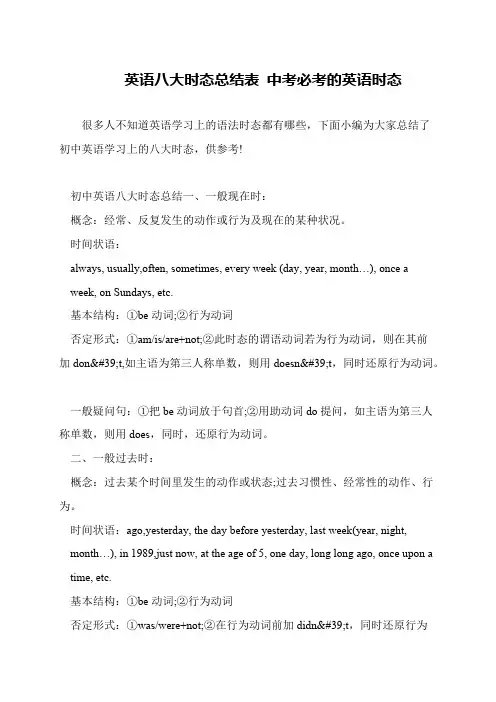
英语八大时态总结表中考必考的英语时态
很多人不知道英语学习上的语法时态都有哪些,下面小编为大家总结了
初中英语学习上的八大时态,供参考!
初中英语八大时态总结一、一般现在时:
概念:经常、反复发生的动作或行为及现在的某种状况。
时间状语:
always, usually,often, sometimes, every week (day, year, month…), once a
week, on Sundays, etc.
基本结构:①be动词;②行为动词
否定形式:①am/is/are+not;②此时态的谓语动词若为行为动词,则在其前
加don't,如主语为第三人称单数,则用doesn't,同时还原行为动词。
一般疑问句:①把be动词放于句首;②用助动词do提问,如主语为第三人称单数,则用does,同时,还原行为动词。
二、一般过去时:
概念:过去某个时间里发生的动作或状态;过去习惯性、经常性的动作、行为。
时间状语:ago,yesterday, the day before yesterday, last week(year, night,
month…), in 1989,just now, at the age of 5, one day, long long ago, once upon a time, etc.
基本结构:①be动词;②行为动词
否定形式:①was/were+not;②在行为动词前加didn't,同时还原行为。
英语八大时态- 英语动词的时态.一般现在时:用动词原形一般过去时:用动词的过去式一般将来时:will/shall+do 或is/am/are going to do过去将来时:could/would do 现在完成时:have/has done过去完成时:had done 将来完成时:shall have done过去将来完成时:would/could have done 现在进行时:is/am/are doing过去进行时:was/were doing 将来进行时:will/shall be doing过去将来进行时:would/could be doing 现在完成进行时:have/has been doing过去完成进行时:had been doing 将来完成进行时:shall have been doing过去将来完成进行时:would have been doing1.一般现在时一般现在时的形式是以动词的原形表示的,当主语为第三人称单数时,做谓语的动词原形后要加上词尾-s or -es, 其构成方式列表如下:情况构成例词一般情况词尾加-s Reads, writes以ch,sh,s,x,o结尾的词词尾加-es Teaches,washes,guesses, fixes, goes以辅音字母+Y 结尾的词变Y为I,再加-es Tries, carries但是,动词to be 和to have 的一般现在时的形式特殊如下:一般动词的词形变化To be 的词形变化To have 的词形变化I know it I am a student I have a pen.You know it. You are a student You have a penHe (she) knows it. He (she) is a student. He (she)has a pen.We (you,they) know it. We (you,they) are students. We (you,they) have pens.一般现在时的功用1. 表示一直发生的事情,经常发生的动作:Nurses look after patients in hospitals. 或Excuse me, do you speak English?I get up at 8 o’clock every morning. 或It often rains in summer in Beijing.2. 表示客观事实或者真理:Birds fly. 或The earth goes around the sun.3. 谈论时间表、旅程表等,如:What time does the film begin? 或The footb all match starts at 8 o’clock. 或Tomorrow is Thursday.4. 谈论籍贯、国籍等,如:Where do you come from? I come from China. 你是哪国人?我是中国人。
英语8种时态的总结归纳
一、英语8个时态
1. 一般现在时:表示经常性或习惯性的动作或存在的状态,常和表示频度的副词often, sometimes, always, usually等连用。
2. 一般过去时:表示过去某个时间发生的动作或存在的状态,常和表示过去的时间状语yesterday, last week, two days ago等连用。
3. 一般将来时:表示将要发生的动作或存在的状态,常和表示将来的时间状语tomorrow, next week, in two days等连用。
4. 现在进行时:表示正在进行的动作,常和表示现在的时间状语now, at this moment, at present等连用。
5. 现在完成时:表示过去发生或已经完成的动作对现在造成的影响,常和表示过去的时间状语yesterday, the day before yesterday, five minutes ago等连用。
6. 过去进行时:表示过去某个时间正在进行的动作,常和表示过去的时间状语yesterday, last week, two days ago, at that time 等连用。
7. 过去完成时:表示过去发生的动作在过去某个时间之前完成,常和表示过去的时间状语yesterday, the day before yesterday, last week等连用。
8. 现在完成进行时:表示从过去某个时间一直持续到现在的动作,常和表示过去的时间状语yesterday, the day before yesterday,
two weeks ago等连用。
以下是初中英语语法八大时态总结表格:时态用法构成时间状语一般现在时表示经常发生的动作或存在的状态主语+动词原形/第三人称单数形式+其他always, usually, often,sometimes, everyday/week/month/year, etc.一般过去时表示过去发生的动作或存在的状态主语+动词过去式+其他yesterday, lastweek/month/year, etc.现在进行时表示现在正在进行的动作主语+am/is/are+现在分词+其他now, at the moment, etc.过去进行时表示过去某个时刻正在进行的动作主语+was/were+现在分词+其他at this time yesterday,etc.一般将来时表示将要发生的动作或存在的状态主语+will/shall+动词原形+其他tomorrow, nextweek/month/year, etc.过去将来时表示过去将要发生的动作或存在的状态主语+would/should+动词原形+其他the next day, etc.时态用法构成时间状语现在完成时表示过去发生的动作对现在造成的影响或结果主语+have/has+过去分词+其他already, yet, ever, never,for/since, etc.过去完成时表示过去某个时间之前已经完成的动作主语+had+过去分词+其他by the time, before, etc.需要注意的是,这些时态的构成和用法可能会有一些例外情况,具体取决于语境和句子结构。
此外,不同的教材和地区可能会有一些差异,因此在学习过程中,建议你参考多种资料,以便更好地理解和掌握这些时态。
英语八大时态总结表
英语八大时态是一般现在时、一般将来时、过去将来时、一般过去时、现在完成时、过去完成时、过去进行时、现在进行时。
一、一般现在时
概念:经常、反复发生的动作或行为及现在的某种状况。
时间状语:always, usually, often, sometimes, every week (day, year, month…), once a week, on Sundays, etc.
基本结构:①be动词;②行为动词
否定形式:①am/is/are+not; ②此时态的谓语动词若为行为动词,则在其前加don't,如主语为第三人称单数,则用doesn't,同时还原行为动词。
一般疑问句:①把be动词放于句首;②用助动词do提问,如主语为第三人称单数,则用does,同时,还原行为动词。
二、一般过去时
概念:过去某个时间里发生的动作或状态;过去习惯性、经常性的动作、行为。
时间状语:ago, yesterday, the day before yesterday, last week(year, night, month…), in 1989, just now, at the age of 5, one day, long long ago, once upon a time, etc.
基本结构:①be动词;②行为动词
否定形式:①was/were+not;②在行为动词前加didn't,同时还原行为动词。
一般疑问句:①was或were放于句首;②用助动词do的过去式did提问,同时还原行为动词。
三、现在进行时
概念:表示现阶段或说话时正在进行的动作及行为。
时间状语:now, at this time, these days, etc.
基本结构:am/is/are+doing
否定形式:am/is/are+not+doing.
一般疑问句:把be动词放于句首。
四、过去进行时
概念:表示过去某段时间或某一时刻正在发生或进行的行为或动作。
时间状语:at this time yesterday, at that time或以when引导的谓语动词是一般过去时的时间状语等。
基本结构:was/were+doing
否定形式:was/were + not + doing.
一般疑问句:把was或were放于句首。
五、现在完成时
概念:过去发生或已经完成的动作对现在造成的影响或结果,或从过去已经开始,持续到现在的动作或状态。
时间状语:recently, lately, since…for…,in the past few years, etc.
基本结构:have/has + done
否定形式:have/has + not +d one.
一般疑问句:have或has。
六、过去完成时
概念:以过去某个时间为标准,在此以前发生的动作或行为,或在过去某动作之前完成的行为,即“过去的过去”
时间状语:before,by,the end of last year(term,month)......
基本结构:had done
否定:had not done
一般疑问句:had放句首
七、一般将来时
概念:表示将要发生的动作,或存在的状态及打算,计划或准备做某事
时间状语:tomorrow,next day,soon,in a few minutes....
基本结构:1、be going to 2、will/shall do
否定:1、was / were not 2、行为动词前加didn't ,同时还原行为动词一般疑问句:1、be 放于句首2、will /shall 提于句首
八、过去将来时
概念:立足于过去某一时刻,从过去看将来,常用于宾语从句中
时间状语:the next day,the following month
基本结构:1、be going to do 2、would /should do
否定:1、be not going to 2、would/should not do一般疑问句:be ,would/should 放于句首。